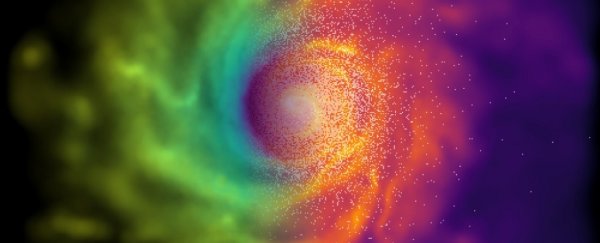Einstein's theory of general relativity has been proven time and again, and is generally accepted as a solid foundation for understanding the Universe. But it's not the only model for explaining how gravity works and galaxies form - and new research has shown a different model under which the Milky Way could have come to be.
Using powerful supercomputers, physicists have simulated the evolution of the cosmos based on a general relativity alternative called f(R) gravity, also known as Chameleon Theory. And these simulations produced disc galaxies with spiral arms, just like the Milky Way.
This shows that the galaxies we see in the Universe around us could still have emerged if the laws of gravity were different.
"Chameleon Theory allows for the laws of gravity to be modified so we can test the effect of changes in gravity on galaxy formation," said physicist Christian Arnold of Durham University.
"Through our simulations we have shown for the first time that even if you change gravity, it would not prevent disc galaxies with spiral arms from forming."
Chameleon Theory is so named because its properties change based on its environment; in addition to the four fundamental forces, it also incorporates a hypothetical 'fifth force'.
We don't know what this fifth force actually is. Much like " dark matter," it's a term for observed phenomena and anomalies that don't fit well into other existing theories or models of how the Universe works. But we can use the parameters of those anomalies to design theories - hence Chameleon Theory.
We know, based on previous mathematical modelling, that Chameleon Theory works just as well as general relativity in the Solar System. But the new research has dialled it up, focusing on the supermassive black holes that can be found at the centres of galaxies.
These are key to the formation and growth of galaxies, since the immense winds that emanate from them can blow away all the gas from which stars are formed - effectively quenching star formation.
Gravity also plays a role in this process, so the team decided to see what would happen when the gravity was governed by Chameleon Theory, not general relativity.
Even with this significant change in gravity, they found galaxies were able to form.
"Our research definitely does not mean that general relativity is wrong," Arnold noted, "but it does show that it does not have to be the only way to explain gravity's role in the evolution of the Universe."
This means there may be other ways to explain other mysteries in the Universe - like the accelerating rate of its expansion, which is faster than it should be based on what we can see. Since this acceleration doesn't play nicely with general relativity, it's usually explained with the theory of dark energy, an unknown repulsive force that's driving the Universe apart.
"In general relativity, scientists account for the accelerated expansion of the universe by introducing a mysterious form of matter called dark energy - the simplest form of which may be a cosmological constant, whose density is a constant in space and time," said physicist Baojiu Li of Durham University.
"However, alternatives to a cosmological constant which explain the accelerated expansion by modifying the law of gravity, like f(R) gravity, are also widely considered given how little is known about dark energy."
The team are hoping that the Square Kilometre Array, a new super powerful radio telescope array due to commence operations next year, could help to resolve this question.
The research has been published in Nature Astronomy.
